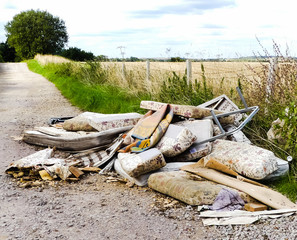Local junk removal companies often recycle or donate mattresses instead of throwing them away. Make sure the mattress is properly wrapped in a mattress bag or covering before setting it out for garbage pickup.

When recycled, the steel springs and foam are turned into new products like carpet padding and insulation. This helps reduce landfill fees and creates revenue for recycling centers.
Every year, millions of old mattresses and box springs end up in landfills. They take years to break down, releasing harmful chemicals into the air and soil that can damage the environment. Recycling mattresses and box springs is a more responsible way to dispose of them.
You can recycle a mattress by taking apart its components and bringing them to a recycling center. Up to 85% of a mattress’s parts are recyclable. Metal springs can be recycled for scrap metal, while foam and wood can go to a facility that uses them to make new products. The fabric on the mattress can be shredded and made into cleaning sponges, while nails and screws can be used to make crafts like plant and candle holders.
Often, your local waste management company will accept your mattress for recycling. However, many companies require that you place your mattress on the curb no more than 24 hours before your trash pick up day and that it be secured in a plastic bag. In addition, you may need to pay a fee to have your mattress picked up by the waste management company.
Some communities have their own municipal recycling programs where you can drop off your mattress for free. These facilities recycle all types of household items and may even offer pickup services for large, bulky items like mattresses. Check with your local municipal office or use an online resource like Earth 911 to find a location near you that accepts mattresses for recycling.
If your town’s recycling program does not accept mattresses, you can still dispose of them responsibly by donating them. Many charities will take your used mattress and box spring, giving them a second life and providing comfort to someone who needs it. You can also try selling your mattress on a local website, such as Facebook Marketplace or on Craigslist.
Donating
Mattresses that are not donated or repurposed can end up in landfills where they take up space and contribute to environmental problems. Recycling and repurposing are better alternatives to trashing. In addition to local charities, there are also a number of online resources that can help you find recycling centers and other locations where you can bring your old mattress for processing.
Before deciding to donate your old mattress, you should check that it is in good condition. This includes being structurally sound and free of odors and infestations. If your mattress has a strong odor, it is important to determine whether it is a result of mold or bed bugs, which can be difficult to get rid of. A bad odor is usually an indication that the mattress has been exposed to moisture or chemicals that can affect its structural integrity and make it unsafe for someone else to sleep on.
You should also remove all sheets, blankets, and any other covers or toppers from your old mattress before donating it. This will ensure that the mattress is clean and ready for its next use. If the mattress has stains, you may need to treat them with specialized cleaning products before vacuuming and re-vacuuming the entire surface. If your old mattress has severe stains, it is a good idea to have a professional remove them.
Some old mattresses can have a great deal of value when they are donated to charitable organizations. However, you should remember that the value of a mattress will depend on its size, condition, and brand.
If you are unable to donate your old mattress, consider dismantling it and bringing the components to a recycling center. Many of these facilities can recycle metal, wood, and foam. You can even recycle the fabric if you are able to separate it from the other parts of the mattress. These recycled materials can be used in a variety of creative art projects and unique home decor pieces. From repurposed steel springs to dog beds made with old mattress padding, the possibilities are endless.
Curbside Pickup
Getting rid of an old mattress takes more than just dropping it off on the curb. You need to know the best way to dispose of it, so you don’t risk contaminating the environment. The most common option is to hire a junk removal company. They will remove your old mattress and take it to a proper disposal site. These services are expensive, but they help reduce landfill waste. They also help you comply with local regulations. The other option is to recycle your mattress yourself. There are a number of recycling centers that will accept used mattresses for low-cost pick up or drop-off.
Some mattress retailers and manufacturers offer pick-up and disposal services to their customers. Ask the store or manufacturer for details. In addition, some cities and counties offer regular bulk collection for items like mattresses. This is a good option if you don’t want to wait for the trash service or you live in a building that does not allow large items on the premises.
Before you put your mattress out for garbage collection, make sure it is sealed in a plastic bag that is any color except orange or red. This is a requirement in some areas to prevent the spread of bed bugs. You can find these bags at many home improvement stores. You should also check your city’s website to determine the specific requirements for putting out bulky items for pickup.
You can also try selling your old mattress online on sites like Craigslist or Facebook Marketplace. If your mattress is in good condition, you may be able to get a decent price for it. Just be sure to take clear, well-lit photos and describe the mattress thoroughly. Emphasize the absence of stains and tears, and reassure prospective buyers that it is free of bed bug infestations.
If you don’t want to invest in a new mattress but you don’t want your old one to end up in the landfill either, you can donate it to a charity that will use it for children’s beds or other programs. Some charities will even pick up your mattress from your home for an additional fee.
Dumpster
If you cannot donate, recycle, or resell your mattress, and you don’t want to throw it out in the trash, there are a few options for disposing of it. You can put it out by your garbage bins on a heavy trash day, or you can call a junk removal service to take it away for you. These services are usually a fee-based, but they can save you time and effort by doing the work for you.
Many waste disposal companies offer mattress recycling for an additional cost. They can break down your old mattress to its raw materials and reuse the parts to make newer mattresses. They can also take the metal, wood, and fabric for separate recycling programs. It’s best to cut up the metal springs and wood frame before placing them in a dumpster. This prevents them from becoming a hazard when you transport them and saves space. It’s also possible to repurpose the foam and the top layer of fabric for cleaning rags or other uses.
Before you place your old mattress in the dumpster, it’s a good idea to vacuum it first. This can remove dust, pet hair, and other debris that may have accumulated. You can also use a non-toxic mattress cleaner or a mixture of water and baking soda to spot clean any stains.
When you’re ready to dispose of your mattress, wrap it tightly in plastic sheeting or another sturdy material. This will keep it from getting wet during the rain and prevents it from becoming a breeding ground for insects and vermin. Make sure the wrapping is secure and that it doesn’t block the sidewalk or street or any fire hydrants or parked cars. You can check your local rules and regulations for more information about how to prepare large items like mattresses for curbside pickup.
Many cities and states have specific rules for throwing away mattresses. You can avoid fines and have peace of mind by following these guidelines. Be sure to check online for guidelines specific to your city or town, and contact the local waste management or recycling service if you have any questions about how to properly dispose of your mattress.



